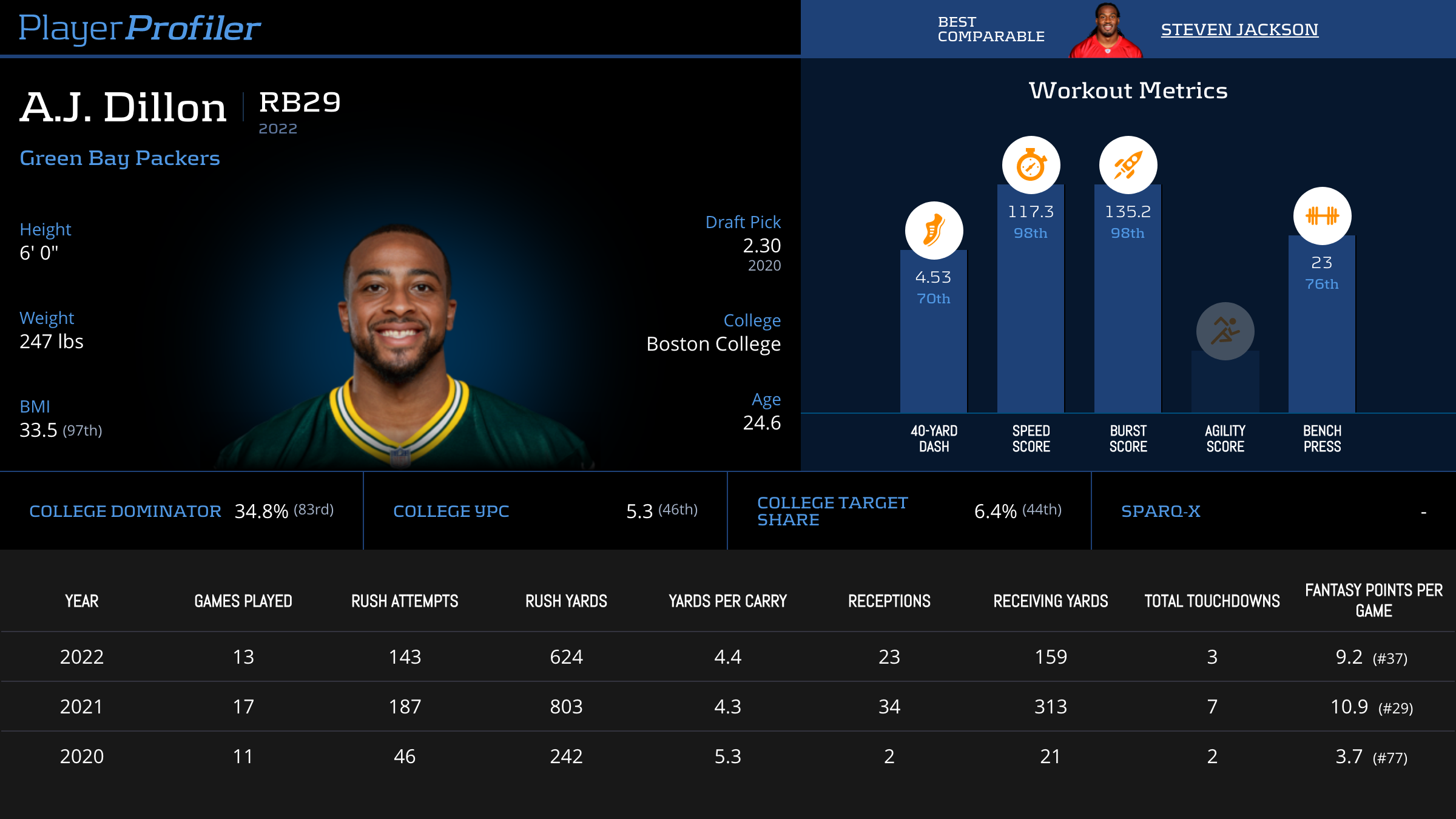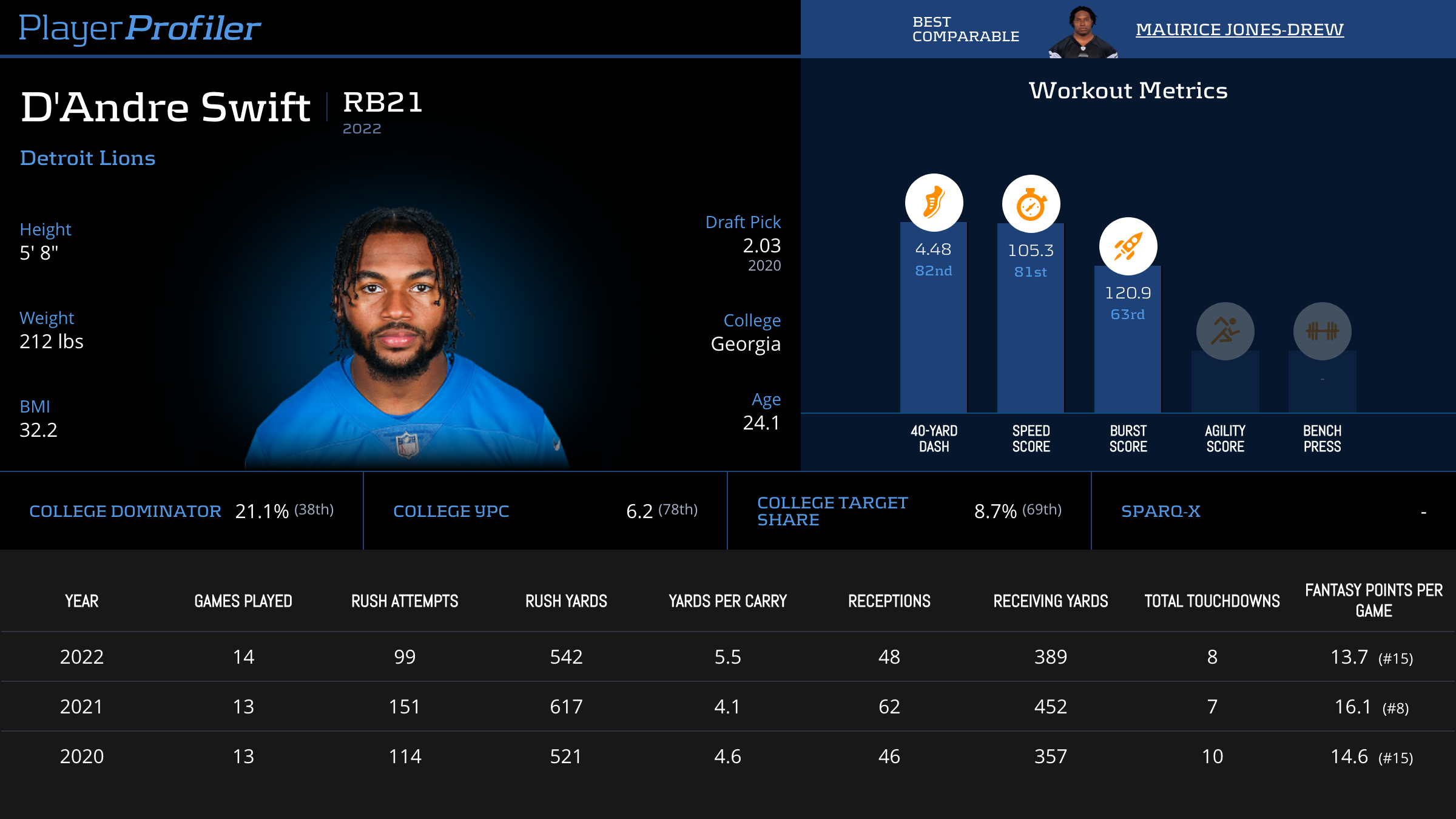An Every-Year Edge
Everyone is looking for an edge in fantasy football. Perhaps the sharpest edge, especially at the volatile running back position, comes from handcuff running backs. These are backs who already have roles in their offenses, but have booming upside if circumstances break right. The upside comes in a myriad of ways. Starting running backs get hurt. Rashaad Penny’s injury paved the way for Kenneth Walker to take the reins in Seattle last season. Sometimes the backup is just straight-up better than the starter. This was the path Tony Pollard and Isiah Pacheco took to stardom a year ago. It happens every year and this year will be no exception. There are plenty of candidates to break out from the middle to late rounds. We will cast a wide net and break down the situation for multiple backs with massive contingent upside.
AJ Dillon, Green Bay Packers
Remember Tony Pollard last season? At this time last year, it was thought that AJ Dillon could have something close to the season that Pollard ended up having. On some sites, Dillon’s ADP was roughly equal to or higher than Pollard’s despite Aaron Jones’ ADP being higher than Ezekiel Elliott’s. Jones has also been a far more efficient player than Elliott in the late stages of their careers. Pollard took off like a rocket, and took Elliott’s job as the primary back in Dallas. Dillon wasn’t able to do the same in Green Bay.
Dillon took a step back in efficiency in 2022. In 2021, he ranked No. 32 among running backs in True Yards Per Carry (4.2), No. 16 in Yards Per Touch (5.0), No. 17 in Yards Created Per Touch (2.9), and No. 5 in EPA (+18.5). In 2022, he finished No. 42, No. 38, No. 44, and No. 85 in those same metrics. The constantly underrated Aaron Jones, meanwhile, finished no lower than No. 14 in any of those metrics in 2022 except for EPA, where he ranked No. 29.

A.J. Dillon Advanced Stats & Metrics Profile
A Backfield Takeover?
It is unlikely that Dillon supplants Jones as the Packers’ starter, but if ever there were season when he would do so, this would be it. First, Jones had the choice of either taking a pay cut to stay a Packer or becoming a free agent. He chose the pay cut. If the Packers were willing to let Jones walk, that is a signal they have faith in giving Dillon a bulkier workload. Jones is going in the dead zone of drafts instead of the first two rounds like he was last year. He is also about to turn 29. Though he hasn’t slowed down yet, it’s possible that begins this season. It’s also possible we were a year too early on Dillon. The good news is instead of being a fifth-round pick, Dillon is now a ninth-round pick.
Zach Charbonnet, Seattle Seahawks
I already wrote extensively about the peculiar circumstances Zach Charbonnet finds himself in with the Seahawks. You can read that article here. It’s worth remembering Kenneth Walker was a boom-bust player as a rookie. In ESPN’s Bill Barnwell’s breakdown of every team’s offensive skill positions (a must-read), Walker ranked No. 41 among 42 qualified running backs in Success Rate. He ranked No. 38 among 42 running backs in DVOA. Walker also came off the field on third downs frequently, in favor of DeeJay Dallas. It is well known Walker did not have a prolific receiving profile in college. He earned only 35 targets in his rookie season in the NFL, and posted just 0.78 Yards Per Route Run. Charbonnet’s college receiving profile, on the other hand, was prolific.
Don’t get it twisted: Walker is good at football. He’s safe as the primary back, but he isn’t bulletproof. Charbonnet excels where Walker is weak. It wouldn’t be surprising if Charbonnet took Seattle’s third down role right away and gradually ate into Walker’s work on the ground from there. We hope Walker stays healthy. If he does miss time, however, Charbonnet and his three-down skillset are set to smash.
Every Philadelphia Eagle
D’Andre Swift
Swift should be the leader of the Eagles’ running back room. He was No. 2 in the NFL among running backs in Yards Per Touch (6.3) last season and Yards Created Per Touch (4.58). Swift was also No. 5 in Yards Per Route Run (1.78), No. 5 in Breakaway Run Rate (8.1-percent), and No. 8 in True Yards Per Carry (4.9). He was awesome last season and has been awesome for his entire NFL career, and yet the Lions could not wait to get rid of him, replacing him with first-round back Jahmyr Gibbs.
Swift can’t seem to stay on the field – either for health-related reasons (he’s missed ten games due to injury) or a lack of trust from the coaching staff. Despite his efficiency, Swift’s opportunity share last season was the lowest it’s ever been – 36.9-percent.

D’Andre Swift Advanced Stats & Metrics Profile
Swift left the door open for Jamaal Williams last season and could do the same for both Rashaad Penny and Kenneth Gainwell this season. Penny has his own health issues to sort out first. He reportedly could start the season on the PUP list because of a broken fibula suffered last season. When he is on the field, he is a dynamic runner. He finished No. 2 in True Yards Per Carry in 2021 (5.2) and No. 1 in 2022 (5.4). However, he is almost an absolute zero in the passing game.
Kenneth Gainwell
Gainwell has the trust of the Eagles’ coaching staff. Three of his five highest snap percentage games came in the playoffs. He is not a zero in the passing game. He recorded 5.4 yards per touch, 2.74 Yards Created Per Touch, and 1.17 Yards Per Route Run in 2022. Those weren’t on the same level with Swift’s numbers, but they are nothing to scoff at.
All the backs in the Philadelphia backfield are going to have a role, and that’s in addition to Jalen Hurts’ work as a rusher. That means the upside of all these backs is capped, but an injury or a loss of trust for any of them will benefit the others. Miles Sanders finished as the RB15 in PPR scoring last season despite earning only 26 targets. It’s possible one of these backs can break that mark. We just don’t know which one. Swift, the market favorite, is the best bet based on his Efficiency Metrics.
Elijah Mitchell, San Francisco 49ers
Elijah Mitchell was a thorn in Christian McCaffrey‘s side last season. Check these numbers, thanks to the great Dwain McFarland on Twitter:
We have 5 data points of Christian McCaffrey with Elijah Mitchell.
CMC averages 58% of the 49ers rushing attempts in games without Mitchell vs. 34% with him.
His fantasy points drop from 25.8 per game to 16.5 — a 36% reduction.
Still the RB1, this weekend, but not unfadable.
— Dwain McFarland (@dwainmcfarland) January 18, 2023
Mitchell is flat-out good. He averaged 4.5 True Yards Per Carry as a rookie, which ranked No. 16 in the NFL. He was even more efficient as a sophomore with a True Yards Per Carry mark of 5.9. He’s good enough that he didn’t disappear from the 49ers’ offense despite the acquisition of McCaffrey. In the six games (including the playoffs) that Mitchell and McCaffrey played together, Mitchell averaged 10 carries per game and more than one target a game. It’s hard to make a consistent fantasy living relying solely on carries, but Mitchell and the 49ers’ offense is good enough that he can be fantasy viable in a pinch with that kind of workload.
Mitchell being involved in the 49ers’ offense makes sense based on the team’s Super Bowl aspirations. They need someone to keep McCaffrey fresh for the playoffs and Mitchell is that guy. If McCaffrey were to get injured again, Mitchell would instantly be a low-end RB1, high-end RB2 option like he was as a rookie when he averaged 15 PPR points per game (RB14). While we know McCaffrey has an injury history, Mitchell does too. So everything here could also apply to Jordan Mason for deeper leagues.
David Montgomery, Detroit Lions
There’s a train of thought that David Montgomery will end up supplanting rookie Jahmyr Gibbs as the Lions’ RB1 this season. That is unless Gibbs is bad. His college production and draft capital suggest otherwise, however. At the same time, D’Andre Swift’s workload was ushered out of the Lions’ facility, and so were the 262 carries and 16 targets handled by Jamaal Williams. Gibbs will not take all that work, so Montgomery will absolutely get his.
https://t.co/Y2xqSOOmJ3 pic.twitter.com/vJnPbpN04u
— Bill Barnwell (@billbarnwell) June 26, 2023
It is highly unlikely whoever took Jamaal Williams’ role was going to score 17 touchdowns like he did. Williams reached double-digit PPR points without the assistance of touchdowns just four times in 17 tries last season. Swift did it six times in 13 games. Gibbs’ role will be more stable, efficient, and predictive for fantasy purposes than Montgomery’s, but if Gibbs’ 5-9 199-pound frame can’t hold up against more massive NFL players, then Montgomery’s ceiling becomes extremely appealing. It’s just hard to see him get there without that happening.
Jaylen Warren, Pittsburgh Steelers
Jaylen Warren has earned some hype this offseason.
"It sure seems to me that Robinson is going to be a big part of the team’s success this year…(Hakeem Butler) put himself into a position where you have to keep your eye on him…there is no way Matt Canada can keep (Jaylen Warren) off the field as much as he did last season" https://t.co/dyoFa7Fquy
— Sigmund Bloom (@SigmundBloom) June 19, 2023
It’s not hard to see why. Warren ranked No. 11 among running backs in Yards Per Touch (5.6). He was also No. 5 in Juke Rate (40-percent) and Yards Created Per Touch (3.82). His efficiency far outpaced Najee Harris’ last season. Warren’s usage increased as the season went along, too.
Carry share before bye: 56.8%
After: 52.9%
(Jaylen Warren: 15.3% to 17.5%)Target share before: 9.5%
After: 9.1%
(Warren: 4.75% to 7.7%)Team run rate before bye: 37.6%
After: 51.4%If they stay 50-50, I'm sure not betting on it being an efficient offense.
— Matt Schauf (@SchaufDS) July 9, 2023
Harris is Pittsburgh’s guy. Warren is not going to supplant him. He might not even have a worthwhile fantasy role either. Warren exceeded double-digit touches just thrice in 16 games as a rookie. He did exceed double-digit PPR points five times, though. Warren is more of a handcuff or a desperation flex play than a backup with standalone value, but I think it’s safe to say that Warren would be a borderline top-12 option if something happened to Harris.
Tyjae Spears, Tennessee Titans, and Tank Bigsby, Jacksonville Jaguars
Tyjae Spears and Tank Bigsby project to replace the roles Dontrell Hilliard and JaMycal Hasty had on their respective teams last season. Those are valuable roles! They can be on the field in some capacity immediately and really take off in the event of an injury to the starter in front of them. I wrote more about them after the NFL Draft that you can read here.
Chuba Hubbard, Carolina Panthers
Chuba Hubbard is basically a last-round pick. That doesn’t make sense. Both head coach (Frank Reich) and running backs coach (Duce Staley) prefer to utilize a committee approach at running back. The Panthers signed Miles Sanders (reuniting him with Staley) to a four year $25 million contract this offseason, but only a little over half ($13 million) is guaranteed. That means the Panthers can get out of it after two seasons.
Sanders has been an excellent rusher during his NFL career. The lowest True Yards Per Carry of his career was 4.2 (his rookie season) and he averages five yards per carry for his career. His passing game usage has waned over the course of his career, however. He posted 1.94 Yards Per Route Run as a rookie. Since then, his Yards Per Route Run numbers are 0.69, 1.05, and 0.36. Hubbard posted 1.29 Yards Per Route Run as a rookie and 1.9 last season. That’s with a smaller sample size, but it’s still a sizable gap in efficiency compared to Sanders.
Coming Through in Spot Duty
Hubbard has produced when given the opportunity. In 2021, McCaffrey missed Weeks 3-8 and 13-18. In those 11 games, Hubbard exceeded double-digit PPR points in six weeks and reached at least nine points in three more. He averaged 10.8 points per game. Hubbard reached double-digit points in three more games after the Panthers traded McCaffrey in 2022 and had two more with at least 9.5 PPR points in nine tries. He registered double-digit touches in five of those games, too. This was while Carolina utilized a committee approach with Hubbard and D’Onta Foreman. We’ve seen Hubbard play well and become fantasy relevant before in both handcuff and committee situations. He’s a good player. Yes, Carolina’s offense doesn’t project to be overly productive, but Hubbard offers some juicy upside you can find super late in your draft.
Capitalizing on Chaos
Projections are a useful tool, but they don’t paint a complete picture for every player. The contingent upside backs fall into that bucket – we cannot possibly project all the chaos that will happen in NFL backfields during the season. The players outlined above have built-in value, but that value skyrockets if the circumstances break right. These jumps in value aren’t captured in traditional player projections. Recognizing those leaps can take place gives us an edge in fantasy leagues. Variance is our friend. If we embrace it, we give ourselves more outs and gain leverage when the variance inevitably hits.


